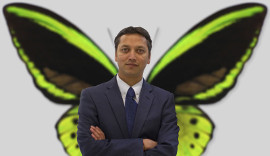Dr. Krushnamegh Kunte
TROPICAL BIODIVERSITY
SPECIATION, TRAIT EVOLUTION AND MORPHOLOGICAL DIVERSIFICATION
EVOLUTION AND GENETICS OF BUTTERFLY WING PATTERNS
Our lab has a broad interest in biology encompassing the fields of natural selection theory, genetics, population and community ecology, and conservation biology. The long-term goal of the lab is to study the organization of biological diversity, the selective processes that shape its evolution, and the means to preserve it in the Indian Region. We specifically use two systems as microcosms to study a range of phenomena that fascinate us, such as morphological evolution, sexual dimorphism and polymorphism, geographical distribution of animals, and speciation.
Our first study system is Batesian mimicry, which is a phenomenon whereby unprotected prey species (called “mimics”) gain protection from predators by mimicking toxic or otherwise protected species (called “models”). Predators learn to avoid models based on prior experience, and subsequently avoid eating mimics due to misidentification. Hundreds of mimetic insects, and especially butterflies, are known from tropical forests. There is tremendous variation in Batesian mimicry: mimicry can be sexually monomorphic, polymorphic or sex-limited within and across species. Our research aims to understand selective pressures that favor such variation in mimetic color patterns, and uncover its genetic basis. Read more about this work on our lab website.
Our second study system is Indian butterflies. India’s butterfly diversity is spread across four globally recognized biodiversity hotspots, and it offers virtually unlimited opportunities to study biogeography, community ecology, population biology and conservation issues. Some Indian butterfly species also exhibit seasonally variable wing patterns, large-scale annual migrations, and phenomenal boom-and-bust population cycles, which make them excellent model organisms to address a wide variety of scientific problems. We study all these phenomena as part of our various ongoing projects. Read more on our external lab website.
SELECTED PUBLICATIONS (TOP 10)
(updated May 2023, see further publications under the Publications page, or the full list of publications on the lab website):
- Basu, D. N., V. Bhaumik, and K. Kunte. 2023. The tempo and mode of character evolution in the assembly of mimetic communities. Proceedings of the National Academy of Sciences, USA, 120:e2203724120. Also featured on the cover.
- Kunte, K., A. G. Kizhakke, and V. Nawge. 2021. Evolution of mimicry rings as a window into community dynamics. Annual Review of Ecology, Evolution, and Systematics, 52:315–341.
- Baral, S., Gandhimathi A., R. Deshmukh, and K. Kunte. 2019. Genetic architecture and sex-specific selection govern modular, male-biased evolution of doublesex. Science Advances, 5:eaau3753.
- Deshmukh, R., S. Baral, A. Gandhimathi, M. Kuwalekar, and K. Kunte. 2018. Mimicry in butterflies: co-option and a bag of magnificent developmental genetic tricks. WIREs Developmental Biology (formally merged in 2022 with WIREs Mechanisms of Disease), 7:e291.
- Arnold, M. L. and K. Kunte. 2017. Adaptive genetic exchange: a tangled history of admixture and evolutionary innovation. Trends in Ecology and Evolution, 32:601–611.
- Joshi, J., A. Prakash, and K. Kunte. 2017. Evolutionary assembly of communities in butterfly mimicry rings. The American Naturalist, 189:E58–E76.
- Kunte, K., W. Zhang, A. Tenger-Trolander, D. H. Palmer, A. Martin, R. D. Reed, S. P. Mullen, and M. R. Kronforst. 2014. doublesex is a mimicry supergene. Nature, 507:229–232.
- Kunte, K. 2009. Female-limited mimetic polymorphism: A review of theories and a critique of sexual selection as balancing selection. Animal Behaviour, 78:1029-1036.
- Kunte, K. 2009. The diversity and evolution of Batesian mimicry in Papilio swallowtail butterflies. Evolution, 63:2707-2716.
- Kunte, K. 2008. Mimetic butterflies support Wallace's model of sexual dimorphism. Proceedings of the Royal Society, B, 275:1617-1624.



